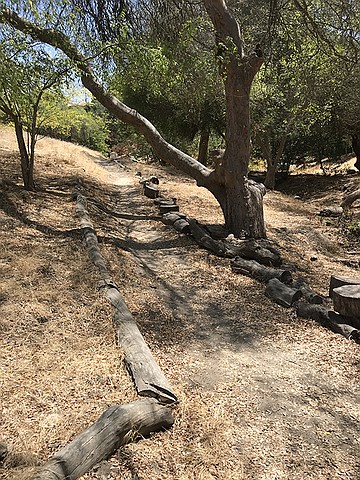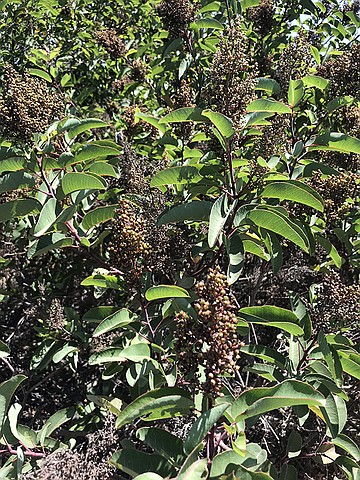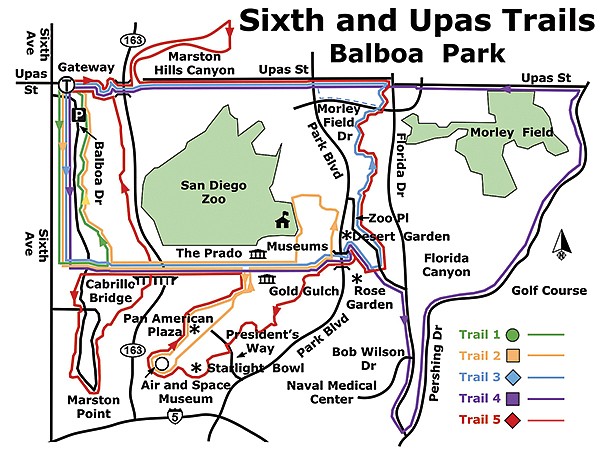 Facebook
Facebook
 X
X
 Instagram
Instagram
 TikTok
TikTok
 Youtube
Youtube

Balboa Park has many treasures, both hidden and well-known. From the buildings created for the Panama-California Exposition to the native plants of Florida Canyon, the Sixth and Upas Gateway Trails allow you to explore both the familiar and obscure.

Five trails start at the corner of Sixth and Upas Gateway to Balboa Park. If you want the full experience, start at the Gateway, and periodic signs will tell you how far you have gone. Your tour re-creates the vision of architect Bertram Goodhue and his Spanish “Dream City” along the park’s El Prado with a quadrangle layout and buildings for the 1915 Exposition. Goodhue’s Spanish Colonial Revival Style forever changed the face of California architecture. His vision for the Dream City on San Diego’s Central Mesa included a grand entry to the quadrangle over a deep canyon connected by a great spanning bridge. The Dream City became the main area of the Panama-California Exposition, and Cabrillo Bridge connects Balboa Park’s West Mesa over Cabrillo Canyon.
Trail 1, marked with a 1 in a green circle, stays on the West Mesa, providing views of the bridge without crossing it. Trail 2, indicated by an orange square, leads you to the Cabrillo Bridge, crossing it into (and exploring) the Dream City on the Central Mesa, leading you past the museums and cottages up to the San Diego Zoo entrance and back. Trail 3, marked by a blue diamond, is a similar but slightly different experience, crossing the bridge into the Dream City, continuing on El Prado and crossing the pedestrian bridge into the Rose Garden. The trail descends into Florida Canyon via the Desert Garden; you leave the imagined past created for the Exposition and enter into a landscape of native plants that thrived in the canyons of San Diego before urbanization and the crafting of the Exposition space. While the trail leads up to Upas Street, take the more scenic Morley Field Drive shortcut to Park Avenue, then take Upas Street (with a pedestrian bridge over the 163) back to the Gateway. Trail 4, marked by the purple square, offers the same initial experience as Trail 3, but instead of going north on Florida Canyon’s nature trails, Trail 4 heads south on Florida Drive, up Pershing Drive along the eastern edge of Morley Field, north to Upas Street, and back across the Upas Pedestrian Bridge.

The most adventurous trail starting at the Gateway is Trail 5, marked by the red diamond. This trail focuses on the urban canyons and takes the route backwards. It starts by heading east on Upas Street, then detours into Marston Hills Canyon. Keep a map handy, as trail markers are inconsistent. Enjoy the natural areas of Florida Canyon before climbing up through the Desert Garden. This route takes you behind the museums and descends into Gold Gulch, named after the gold panning area at the 1935 Exposition where the Australian Garden is today. The trail leads you below the Japanese Friendship Garden before climbing up to President’s Way, and continuing behind the Starlight Bowl and Air and Space Museum. This trail also provides a sweeping view of downtown across Cabrillo Canyon from the overlook at the end of Pan American Plaza. It then passes the International Cottages, returning to the center of the Dream City at the Plaza de Panama and turning west to cross the Cabrillo Bridge. Trail 5 offers one more loop — head south to the tip of Marston Point, overlooking downtown again, and then complete the loop going below the Cabrillo Bridge. Continue north to Upas Street and head west to return to the Trailhead at Sixth Avenue.
Sixth and Upas Gateway Trails
Discover Balboa Park on the Sixth and Upas Trails

Driving directions: From CA-163 S use the right 2 lanes to take exit 2C toward 6th Avenue/University Avenue. Go 0.2 mile. Continue onto Sixth Avenue and go 0.8 mile. The Upas Street Gateway will be on your left just before Balboa Drive. Turn left on Balboa Drive and park, paying attention to posted parking regulations. Hiking length: Variable: Trail 1 is 1.5 miles; Trail 2 is 4.1 miles; Trail 3 is 3.6 miles; Trail 4 is 5.4 miles; and Trail 5 is 6.6 miles. Allow 2-4 hours, depending on the trail. Difficulty: Variable: Trail 1 is easy, no elevation change, and is appropriate for all ages and wheelchair accessible; Trail 2 is moderate, with paved walkways and minor elevation changes; Trail 3 is difficult with steep dirt trails and over 200 feet in elevation change; Trail 4 is moderate with steep paved slopes and nearly 300 feet in elevation change; and Trail 5 is difficult with steep dirt trails and about 500 feet in elevation change going up and down between canyons. Facilities are located throughout the park.


Balboa Park has many treasures, both hidden and well-known. From the buildings created for the Panama-California Exposition to the native plants of Florida Canyon, the Sixth and Upas Gateway Trails allow you to explore both the familiar and obscure.

Five trails start at the corner of Sixth and Upas Gateway to Balboa Park. If you want the full experience, start at the Gateway, and periodic signs will tell you how far you have gone. Your tour re-creates the vision of architect Bertram Goodhue and his Spanish “Dream City” along the park’s El Prado with a quadrangle layout and buildings for the 1915 Exposition. Goodhue’s Spanish Colonial Revival Style forever changed the face of California architecture. His vision for the Dream City on San Diego’s Central Mesa included a grand entry to the quadrangle over a deep canyon connected by a great spanning bridge. The Dream City became the main area of the Panama-California Exposition, and Cabrillo Bridge connects Balboa Park’s West Mesa over Cabrillo Canyon.
Trail 1, marked with a 1 in a green circle, stays on the West Mesa, providing views of the bridge without crossing it. Trail 2, indicated by an orange square, leads you to the Cabrillo Bridge, crossing it into (and exploring) the Dream City on the Central Mesa, leading you past the museums and cottages up to the San Diego Zoo entrance and back. Trail 3, marked by a blue diamond, is a similar but slightly different experience, crossing the bridge into the Dream City, continuing on El Prado and crossing the pedestrian bridge into the Rose Garden. The trail descends into Florida Canyon via the Desert Garden; you leave the imagined past created for the Exposition and enter into a landscape of native plants that thrived in the canyons of San Diego before urbanization and the crafting of the Exposition space. While the trail leads up to Upas Street, take the more scenic Morley Field Drive shortcut to Park Avenue, then take Upas Street (with a pedestrian bridge over the 163) back to the Gateway. Trail 4, marked by the purple square, offers the same initial experience as Trail 3, but instead of going north on Florida Canyon’s nature trails, Trail 4 heads south on Florida Drive, up Pershing Drive along the eastern edge of Morley Field, north to Upas Street, and back across the Upas Pedestrian Bridge.

The most adventurous trail starting at the Gateway is Trail 5, marked by the red diamond. This trail focuses on the urban canyons and takes the route backwards. It starts by heading east on Upas Street, then detours into Marston Hills Canyon. Keep a map handy, as trail markers are inconsistent. Enjoy the natural areas of Florida Canyon before climbing up through the Desert Garden. This route takes you behind the museums and descends into Gold Gulch, named after the gold panning area at the 1935 Exposition where the Australian Garden is today. The trail leads you below the Japanese Friendship Garden before climbing up to President’s Way, and continuing behind the Starlight Bowl and Air and Space Museum. This trail also provides a sweeping view of downtown across Cabrillo Canyon from the overlook at the end of Pan American Plaza. It then passes the International Cottages, returning to the center of the Dream City at the Plaza de Panama and turning west to cross the Cabrillo Bridge. Trail 5 offers one more loop — head south to the tip of Marston Point, overlooking downtown again, and then complete the loop going below the Cabrillo Bridge. Continue north to Upas Street and head west to return to the Trailhead at Sixth Avenue.
Sixth and Upas Gateway Trails
Discover Balboa Park on the Sixth and Upas Trails

Driving directions: From CA-163 S use the right 2 lanes to take exit 2C toward 6th Avenue/University Avenue. Go 0.2 mile. Continue onto Sixth Avenue and go 0.8 mile. The Upas Street Gateway will be on your left just before Balboa Drive. Turn left on Balboa Drive and park, paying attention to posted parking regulations. Hiking length: Variable: Trail 1 is 1.5 miles; Trail 2 is 4.1 miles; Trail 3 is 3.6 miles; Trail 4 is 5.4 miles; and Trail 5 is 6.6 miles. Allow 2-4 hours, depending on the trail. Difficulty: Variable: Trail 1 is easy, no elevation change, and is appropriate for all ages and wheelchair accessible; Trail 2 is moderate, with paved walkways and minor elevation changes; Trail 3 is difficult with steep dirt trails and over 200 feet in elevation change; Trail 4 is moderate with steep paved slopes and nearly 300 feet in elevation change; and Trail 5 is difficult with steep dirt trails and about 500 feet in elevation change going up and down between canyons. Facilities are located throughout the park.
Comments